Keywords shape every move you make in SEO, so identifying keywords for SEO should always come first—before you write a single word of web copy.
Whether it’s a landing page, service page, blog post, or even your brand positioning statement (and as a brand strategist, I’d argue that’s a big one), knowing the right keywords is key.
Even basic keyword research and analysis in seo helps you make smarter, data-driven decisions.
It shows you where traffic is going, where you have ranking opportunities, and how to structure your site the right way.
You can design a beautiful website with uniquely branded products or service names—but does it attract the right traffic, or at the very least any traffic?
Skipping this step—or worse, guessing—is a recipe for getting no traffic. A common mistake? Using product or service names that sound great internally but don’t match what people actually search for.
You have to be strategic. Identify the right keywords first through a thorough keyword optimization search, and then create content that works for both users and search engines.
Follow the following step by step keyword search strategy to target the right traffic for your small business.
Step One: Brainstorm Keyword Ideas for Your Keyword Search Strategy
Start with Your Brand: Who Are You Targeting?
If you’ve established a strong brand identity, this part is easy. If not… well, why are you even in business? The real power of the SEO research process isn’t just about ranking—it lies in understanding your audience and how they search for your products or services.
Ask yourself:
- Who is your ideal customer?
- What problems do they need solutions for?
- How do they describe those problems?
- What kind of information are they searching for related to your services
For B2B businesses, this step is just as important. Before you can help a company grow through SEO, you need to understand their business, their customers, and their goals. Keyword research and analysis in SEO depends on knowing your audience deeply.

Define Your Niche (Don’t Skip This!)
Too many businesses cut corners here because the keyword research process in SEO consumes a lot of time. They assume they already know what they want to rank for—only to realize later that their audience is searching for something completely different.
Because, what you want to rank for and what your audience actually searches for are often two very different things. SEO keyword research strategy should focus on your audience first and use keyword data to refine those insights, leading to much stronger and more successful SEO strategies.
Example: Birthday Bliss Box
Let’s say you own Birthday Bliss Box, a company that curates and delivers customized birthday gift boxes based on the recipients preferences. Now you want to dive into the world of SEO and digital marketing.
Before getting into keyword tools, you need to define your products and customers.
- What are you selling? Curated birthday gift boxes, personalized gifts, subscription-based gifting, last-minute birthday gifts.
- Who are your customers? People looking for thoughtful and convenient birthday gifts—Busy professionals, long-distance friends and family, parents, or companies sending gifts to employees.
- What problems do you solve? You save customers time, provide unique and personalized gifts, and offer a stress-free way to celebrate birthdays.
Once you define this, it naturally leads to keyword ideas like:
- Personalized birthday gift boxes
- Best birthday subscription boxes
- Unique birthday gift ideas
- Last-minute birthday gifts with fast shipping
See how these keywords directly reflect your customers’ needs and how your business solves their problems?
That’s how you build an effective keyword search strategy that matches real intent—rather than generic ones like gifts or birthday presents.
How Do People Search for What You Offer?
You might have a great way of describing your product or service, but how does your audience search for it? That’s the key to identifying keywords for SEO and choosing the right ones.
If you’re writing a blog post, start by brainstorming related words and phrases. Think about what someone would type into Google when looking for information on your topic. If you already have a well-established business, you probably have a few keywords in mind—but make sure they align with how your audience actually searches.
Create Your Initial Keyword List
During this step, build a list of broad, relevant terms that you can refine later. Here’s how to start:
- List core topics related to your business.
- Expand to include synonyms, variations, and related searches.
- Pay attention to how real people search—and watch the ideas flow
Step Two: Choose the Best Keywords for Your Niche
You now have a solid idea of your products and your audience. You are able to list keyword ideas that describe your products, services, and the problems you solve. It’s time to narrow them down.
Pick a Niche You Know Well
Start by choosing a topic you’re confident in—something you can write about with authority. This is your niche. For example, my focus is SEO research and discovery for small businesses.
Before you get into keyword research tools, take a step back and look at what real people are asking online. Keyword research and strategy isn’t just about words—it represents real questions and needs.
Find the Questions People Are Asking
People search for answers, and that’s where you come in. Find out what they’re asking, and position yourself as the expert who provides the best answers. Here are some tools to help:
- Reddit – A goldmine of real conversations and burning questions. Browse relevant subreddits in your niche.
- QuestionDB – Enter broad topics from Step One, and it will generate a list of related questions people are asking online.
- Answer The Public – Another great tool for uncovering common questions. Be sure to filter by country and language to keep results relevant.
- Buzzsumo – Their “Question Analyzer” pulls frequently asked questions across multiple platforms.
People ask questions. Hunt for ones relevant to your topic. You provide answers. It’s that simple. Keyword research tips for SEO strategy always prioritize user intent.
Spy on Search Results (SERPs)
Don’t try to reinvent the wheel. Instead, analyze what’s already ranking and learn from it.
- Google Your Keywords – Search for terms like Best Home Workouts and study the top-ranking pages.
- Check Google’s “People Also Ask” Section – These are real questions people search for, making them excellent keyword ideas.
- Look at Related Searches – Scroll to the bottom of Google’s search results for more keyword variations.
By doing this, you’ll uncover gaps and opportunities—things top-ranking pages might be missing that you can capitalize on. Competitive keyword research for SEO is a game-changer in this step.
Focus on Untapped, Trending Keywords
New and rising keywords are often less competitive, making them a great way to break into search rankings.
Stay ahead of the curve by tracking trends in your industry. You can even target geographically.
- Exploding Topics – This free tool helps you spot emerging trends before they become mainstream. Pick a category, scroll through results, and add relevant topics to your keyword list.
- Google Trends – See how keyword popularity changes over time. This helps you plan ahead and account for seasonal trends. An effective Keyword search strategy depends on spotting trends early.
Analyze Your Competitors
Why start from scratch when you can learn from others? Identify key competitors in your niche and analyze the keywords they target.
- What topics do they cover?
- What gaps can you fill?
- Are there underserved areas where you can dominate?
This is how you refine your best keyword strategy—by balancing what’s working now with what’s up-and-coming.
The best keyword research strategy always considers both current and future search trends.
follow these steps, and you’ll be well on your way to finding the right keywords for SEO and building an effective, long-term SEO keyword guide that drives traffic and conversions.

Step Three: Finding the Right Keywords & Analyzing Them
By now, you’ve got a solid list of keyword ideas. But we’re not here to find one perfect keyword—we need a main keyword and its variations to ensure an effective keyword optimization search.
Think of it this way:
- Your main keyword is your foundation.
- Its variations are the supporting pillars that help search engines (and people) understand your content.
If you’re structuring an entire website, your keywords will define your main categories and subcategories. Think of these as your core topics and subtopics for your niche. When you write on these, you become an authority in your field and users will start trusting your brand. Learn more about topical authority in SEO.
If you’re writing a blog post, you’ll need multiple variations to sprinkle throughout your copy naturally.
This is where a solid keyword research process in SEO comes into play.
Why Keyword Analysis Matters
Once you enter your seed keywords into a research tool, you’ll uncover even more related keywords, common questions, and content ideas you might have missed.
That’s why this step isn’t just about picking words—it’s about finding the best strategic keywords that align with your goals and audience.
You need to cherry pick the right keywords terms that will drive conversions.
So, how do you know which keywords are worth using? This is where keyword research and analysis in SEO comes in.
How to Analyze Keywords
To determine which keywords give your website the best shot at ranking, you’ll look at three key factors:
- Search Volume – How many people search for this keyword each month?
- Keyword Difficulty – How hard is it to rank for this keyword?
- Competition Analysis – What keywords are your competitors already ranking for? This falls under competitive keyword research for SEO.
So it’s time to fire up your favorite keyword research tool to refine your SEO keyword selection.
Keyword Search Strategy Tools to Help You Find the Best Keywords
There are plenty of great tools to help you analyze keywords. Some of the most reliable contenders include:
- Google Keyword Planner – performing keyword research and strategy with keyword planner allows you to view keywords other businesses are willing to pay. It’s great for low search volume insights but valuable long-tail keywords.
- SEMrush – Comprehensive SEO tool with keyword research, competitor analysis, and domain insights.
- Ahrefs – Excellent for tracking search traffic, keyword difficulty, and backlink profiles.
- Moz Keyword Explorer – Helps you understand keyword difficulty and search intent.
A Pro Tip for Google Keyword Planner: Most people use it as a keyword generator—entering broad topics and getting a list of common searches. But if you want to go beyond what your competitors already know, use the “Start With a Website” feature.
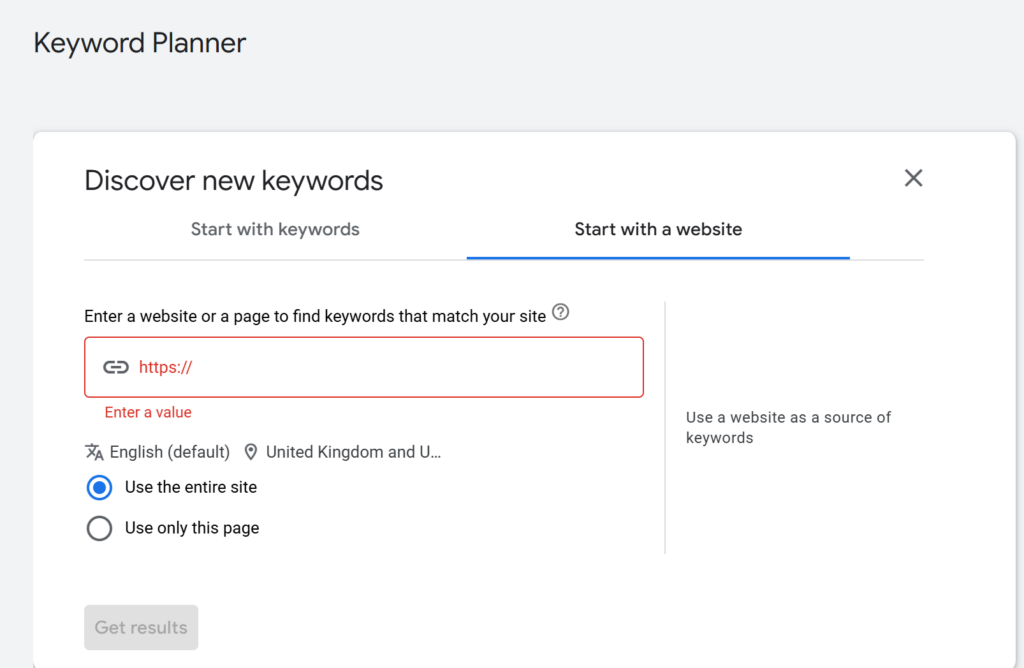
Enter a competitor’s URL, and Google will analyze the page’s content to suggest keyword ideas. This can help you find opportunities others might be overlooking in SEO research and discovery.
What’s Next?
As you analyze your keywords using an SEO keyword discovery tool, your job is to pick the ones that match your needs.
But how do you choose the right mix? That’s what we’ll cover in the next step!
Understand Search Intent
You need to understand the intent behind each keyword.
An effective keyword search strategy involves identifying what searchers are actually looking for.
Search intent tells you why someone is searching.
Are they looking for information? Ready to make a purchase? Just browsing? Knowing this helps you create content that actually meets their needs. This is a core part of keyword planning strategy.
The Different Types of Search Intent
- Informational Intent (Top of Funnel) These are searches from people who are just starting to explore a topic. They want answers, not sales pitches.
Example: “How to start working out” would be great
Instead of: “Buy workout equipment online”
At this stage, your job is to educate and build trust with effective keyword search strategies.
- Commercial Intent (Middle of Funnel) These users already know a bit about the topic and are looking for something specific—maybe a brand, a product, or a comparison.
Example: “Best workout equipment for home gyms”
Example: “Flat bench press vs. incline bench press”
They’re moving toward a decision, so your content should help them compare options and feel confident in their next step.
- Transactional Intent (Bottom of Funnel) This is where people are ready to take action—whether that’s making a purchase, signing up, or booking a service.
Example: “Best price for Bowflex home gym”
Example: “Puppy training in Seattle, WA”
These searchers don’t need a long introduction—they need a clear call to action (like a “Buy Now” or “Sign Up” button).
Matching Search Intent to Your Content
There are two ways to identify the search intent of a keyword.
One is by using your keyword research tool. For instance let’s use Semrush.
When you type the keyword “birthday gifts for her” into Semrush’s search bar
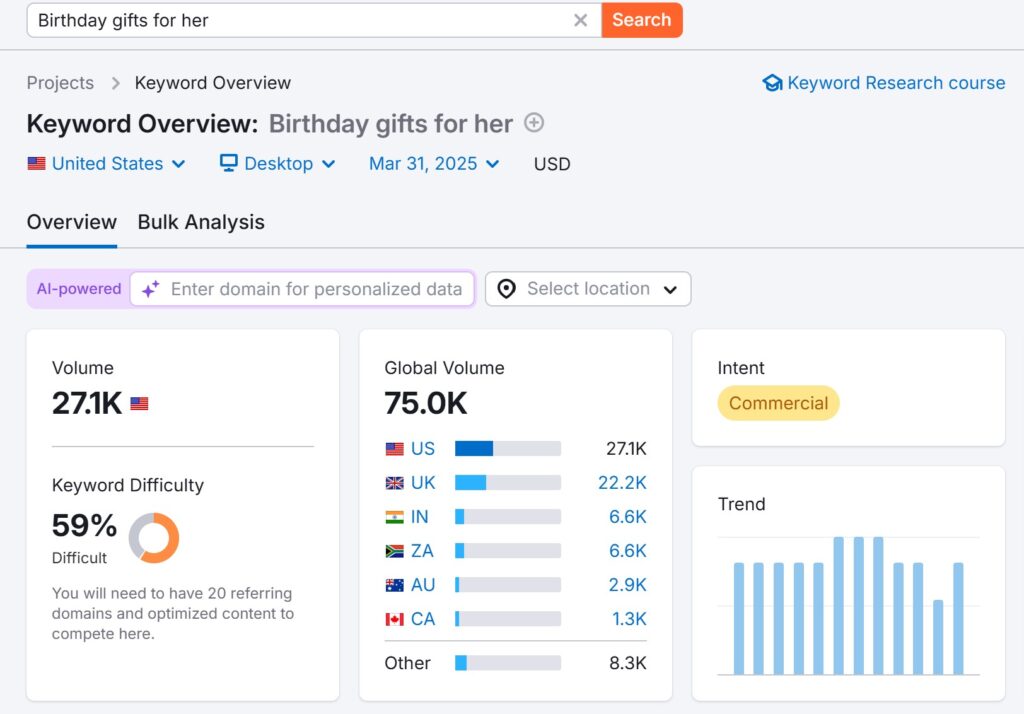
As you can see the intent is commercial.
You can confirm this intent by looking at the SERPS: Let’s say you google Birthday gifts for her,

As you can see the type of content here is mostly listicles with birthday gifts and their prices. This means you are not going to write an “how to article”.
The key to ranking well and engaging your audience is making sure your content matches what searchers actually want. This is why keyword research and analysis in seo is necessary.
Do your analysis and ask yourself:
✔ Are people looking for guides or how-tos? (Informational)
✔ Do they want product reviews or comparisons? (commercial)
✔ Are they ready to buy or sign up? (Transactional)
Transactional keywords usually have the terms: “subscribe,” “buy,” “for sale”
If you tailor your content to what the searcher is actually looking for, you’ll have a better chance of ranking higher—and turning visitors into customers.
Learn what is search intent in SEO and how you can optimize your content for it
Pay Attention to High CPC Keywords in Your Keyword Search Strategy
A lot of people make the mistake of chasing high-search-volume keywords without considering what really matters: commercial intent.
Finding the right keywords for SEO means understanding their value.
Sure, you might rank for keywords that get tons of searches. But if those searchers aren’t ready to buy, what’s the point? Unless your goal is purely to educate and build awareness, you need to think strategically.
What High CPC Keywords Tell You
One of the best ways to spot keywords with buying intent is by looking at CPC (Cost Per Click). Why? Because if businesses are paying for clicks on a keyword, that means they see real sales potential in those searches.
Therefore paying attention to such keyword optimization search metrics helps refine your targeting.
People searching for these terms may not buy today or tomorrow, but they’re in the market. And when they’re ready, you want your brand to be top of mind.
So as you filter through your keyword list, don’t just look at search volume—pay attention to CPC.
How do you find CPC value for your keyword? The Semrush Keyword tool has a section for CPC.
Go to Semrush then open the keyword overview on the left side pane. Add your keyword on the search bar and on the keyword metrics you can see its CPC:
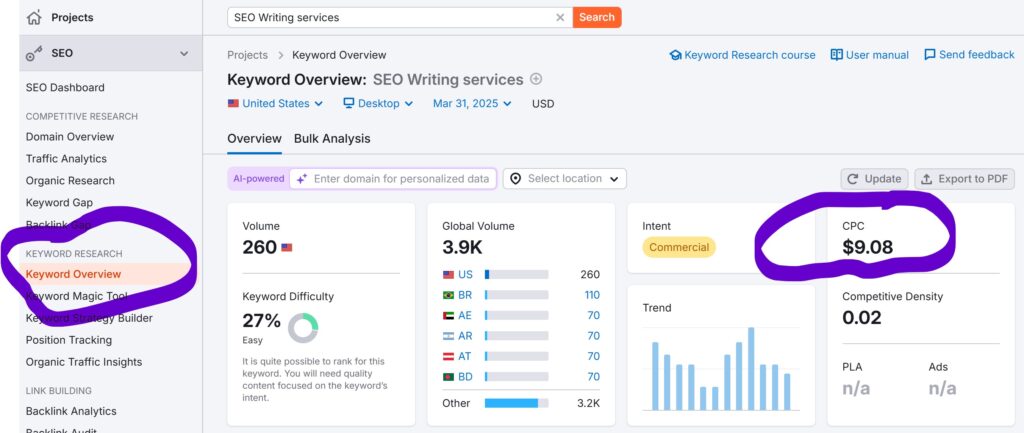
What’s Considered a High CPC?
There’s no universal answer—it depends on your niche.
💰 Marketing niche → A CPC of $5+ is pretty normal.
💸 Personal finance niche → $5 is nothing; CPCs can be much higher.
🏋 Fitness niche → A CPC of $5 is considered high.
Don’t get hung up on an exact number.
But as you do your keyword research and analysis for SEO just look for keywords with an above-average CPC in your industry—they’re usually a strong indicator of buying intent.
Check Keyword Difficulty (KD)
Keyword difficulty (KD) tells you how hard it is to rank for a keyword. Most SEO tools, like Semrush, give each keyword a KD score based on the competition on the first page.
🔹 If you’re just starting out, avoid keywords with a KD above 50%—they’ll be tough to rank for. Focus on building a strong site, acquiring plenty of quality backlinks, writing solid content, and you can aim higher.
Look at Search Volume
Now that you’ve filtered out high-KD, low-CPC keywords, it’s time to see which ones actually get searched. I typically avoid high volume keywords.
High search volume usually means high competition—ranking for these will take time and effort.
SERP features (like featured snippets, carousels, or knowledge panels) can make a keyword even harder to rank for.
Big brands dominate high-volume keywords, so if you’re new, ranking for them could take years of work.
So while it’s tempting to chase keywords with 50,000+ searches a month, remember that high volume doesn’t always mean high intent. You don’t want to attract visitors who have no interest in what you offer.
A keyword research and analysis for SEO ensures you target keywords that get a reasonable number of searches each month.
Go too high, and you’ll struggle to rank. Go too low though, and you won’t get traffic. Find those with a reasonable amount of searches every month.
Don’t Underestimate Long-Tail Keywords
Long-tail keywords might not get tons of searches, but they’re easier to rank for and way more targeted to the right audience.
And here’s the best part—because they’re so specific, they tend to have higher conversion rates than broad, high-volume keywords.
Think about it this way:
🔹 Someone searching for “running shoes” is probably just browsing.
🔹 But someone searching for “best cushioned running shoes for knee pain” knows exactly what they want—and is way more likely to buy.
🔹 And someone searching for “best price red women’s size 7 running shoe” has their card out.
Most keyword tools will suggest related search terms and long-tail variations—use them!
Sprinkle these naturally throughout your content to help search engines and readers better understand the context of your page.
Find the Sweet Spot
Your ideal keywords should:
✔ Not be super competitive
✔ Have a decent CPC (indicating buying intent)
✔ Get a reasonable number of searches each month
The real SEO magic happens when you target high-volume, low-competition keywords. But don’t be afraid to go for lower-volume, high-intent keywords—they add up fast.
Get More Strategic with Your Keyword Analysis
By now, you’ve nailed down which keywords make sense for your site based on difficulty, CPC, and search volume.
But there’s still room to level up your SEO research process by looking at competitors, seasonality, and location-based searches.
1. Analyze Your Competitors
Your competitors can give you valuable insights into SEO research and discovery—specifically, which keywords are worth going after.
To perform a Competitive keyword research for seo you an use Semrush competitive research tool.
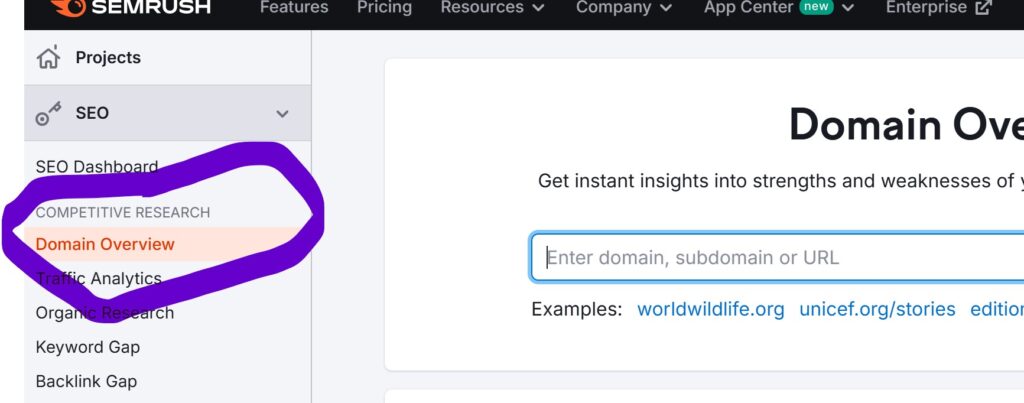
So, how do you decide which ones to prioritize?
🔹 Find the gaps – Look for high-volume keywords that your competitors aren’t ranking for. This gives you an opportunity to claim that space before they do. Go over to semrush keyword gap section.

🔹 Go head-to-head – Check which keywords your competitors are already ranking for and target those too. This is a more aggressive SEO keyword research strategy, but if you can outperform them, you’ll take some of their traffic.
Hover over to Semrush’s Domain overview section on the left pane.

Type your competitor’s domain or page URL into the search bar and see which keywords bring organic and paid search traffic to that domain
Think Seasonally: When Do Searches Peak?
Some keywords get huge spikes at certain times of the year. If you know when people search for a term, you can plan content ahead of time and maximize traffic during peak months.
🔹 Example: “Christmas gift boxes” in the UK starts trending from October to December—so you’d want to publish and promote your content well before then.
Use Google Trends or SEO keyword discovery tools to track seasonal patterns and get ahead of the competition.
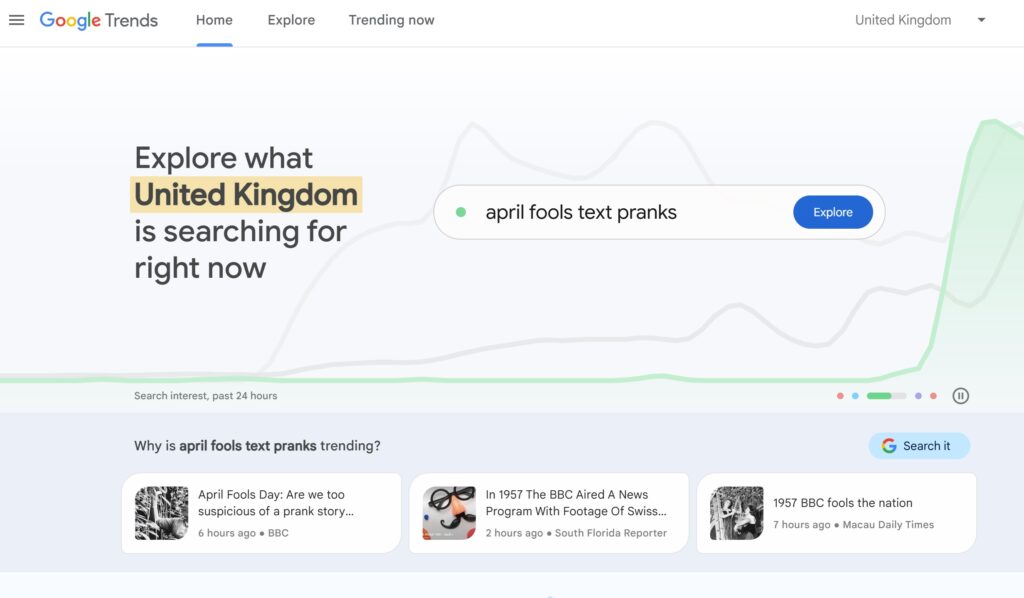
Targeting by Location: Speak Their Language
Not all searches are created equal—terms can vary by region. If your audience is location-specific, research keyword research and analysis in SEO to make your content more relevant.
🔹 Example: In Texas, people say “big rig” for a large truck, but in New York, they use “tractor-trailer.”
🔹 Use Google Keyword Planner or Google Trends (“interest by subregion”) to spot these differences and optimize accordingly.
Diversify: Pages, Not Just Websites, Rank
Your homepage won’t carry all the weight—Google ranks individual pages for keywords. Instead of trying to rank one page for everything, spread the wealth:
✔ Optimize multiple pages for different valuable keywords using an effective keyword search strategy.
✔ Create specific, well-targeted content that directly answers search intent.
By the way I specialize in keyword optimization search to build an overall content strategy for your entire website. If you want to make sure every page of your website targets the right keywords and works harmoniously with other sections without confusing Google and users, text me.
The Best Keyword Strategy for Small Businesses
If you apply the methods we just covered, you can build a site that attracts millions of searches—yes, really!
I remember when I published my first article, it attracted a thousand views.
Now, if your site is new, has low authority, and operates in a competitive niche, your best bet is to target keywords that big sites overlook—long-tail keywords.
Why Long-Tail Keywords?
✔ Less competition – Big websites often don’t have dedicated pages for them.
✔ Higher conversion rates – They’re more specific, meaning searchers already know what they want.
✔ More opportunities – Even if individual search volumes are low, they add up fast!
But it all comes down to finding the right opportunities. The more keyword research and strategy you do, the better your results will be.
I’m going show a method that combines those methods and has worked wonders for me and my clients.
Every business is different, so there’s no one-size-fits-all approach. Play around and you will find the best keyword strategy that works for you.
But this keyword planning strategy works well for most small businesses. Feel free to tweak it based on your niche and goals.
Start with the Search Results Page
Before diving into SEO keyword selection, start with the search engines themselves. Google, Bing, and even YouTube can give you instant insights into how people search for your topic.
Try typing in different variations related to your topic. For example, if you’re researching birthday gifting, test out phrases like:
“What birthday gifting…” “How birthday gifting…” “When birthday gifting…” “Why birthday gifting…”
For instance, when you “how birthday gifting” the People Also Ask section might suggest “How to present a gift to someone?”—a potential keyword worth exploring.
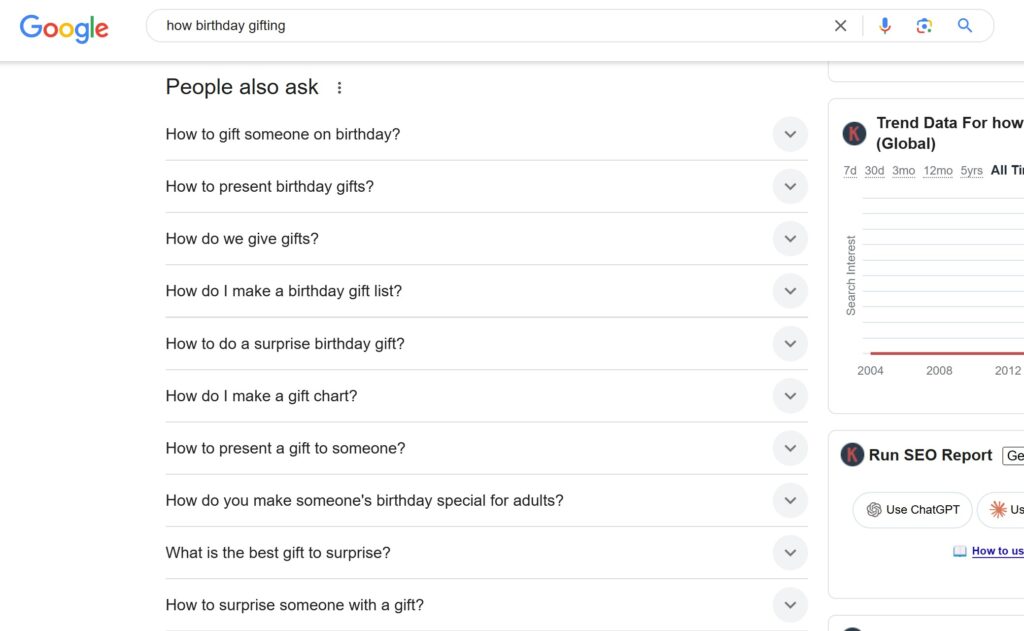
Next, Use a Keyword Tool
Now, take things a step further with top seo keyword free tools. The Keywords Everywhere browser extension is great for pulling additional keyword suggestions from your searches.
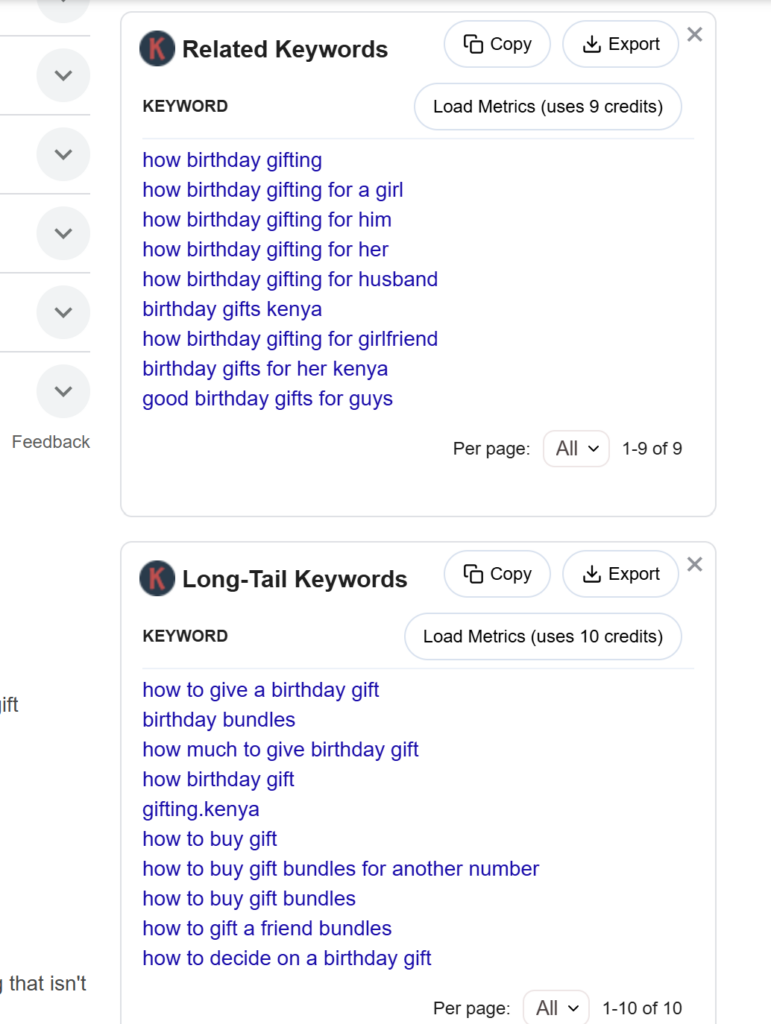
N/B the kewyords everywhere tool is an extension you download and install as an extension for your chrome.
You can also use tools like AnswerThePublic or QuestionDB to uncover unique keyword ideas.
Write down all the keywords that stand out—especially ones that seem niche but relevant.
Dig Deeper with Keyword Research and Analysis for SEO Tools
Take your list of keywords and run them through Semrush or Ahrefs to analyze their competition and search volume.
Focus on keywords that show low or even zero search volume in these tools.
Many people ignore these, but they often have real search potential and clear intent.
Verify with Google Keyword Planner
Export those zero-volume keywords and plug them into Google Keyword Planner to get a better sense of their actual search traffic.
Look for:
10-100+ monthly searches
A steady or growing trend over time
For example, while a tool like Semrush might show zero searches for “What do you say when giving a birthday gift?”, Google Keyword Planner might reveal 100 searches per month with increasing interest—meaning it’s a keyword worth targeting.
Check Google Trends
Before committing to a keyword, run it through Google Trends (focusing on your target country). This helps confirm whether interest in the keyword is:
- Consistent year-round (great for evergreen content)
- Seasonal (useful for timing your content)
You can also explore discussions on Reddit and Quora to see if people are actively asking about the topic.
Only after a keyword passes all these checks should you start creating content around it.
This best keyword strategy helps uncover hidden gem keywords that:
✅ Have actual search volume (confirmed by Keyword Planner)
✅ Show growing interest (year-over-year increase)
✅ Have less competition (since they show up as zero-volume in Semrush)
✅ Reflect real user interest (validated by Google Trends and forum discussions)
Using this keyword optimization search strategy, you’re not just chasing high-volume keywords—you’re finding real opportunities that others might be missing!
Use “People Also Ask” to Find Content Themes and Search Intent
Before getting into writing, take a moment to analyze the theme of a search results page (SERP).
A great way to do this is by exploring the People Also Ask (PAA) section on Google.
These are real questions people are searching for, and they can help you uncover topics and subtopics to make your content more in-depth and valuable.
Here’s how to do it:
1️⃣ Search Your Keyword on Google – Type in one of the keywords you found during your research.
2️⃣ Check the “People Also Ask” Section – Click on one of the suggested questions at the top or bottom of the search results. These are related queries that searchers commonly look for.
3️⃣ Analyze the New Search Results – Look at the top-ranking pages and note any recurring words, phrases, or specific details (like product features, industry terms, or brand names).
4️⃣ Explore More Suggestions – Go back to your original search, click on another related query, and repeat the process to gather even more relevant terms.
5️⃣ Group Similar Terms – Once you’ve gathered a good list of keywords, group them by theme. This helps you understand the broader topic structure and how to naturally weave these subtopics into your content.
Why This Works
When you incorporate these related terms and questions naturally into your content, you’re aligning it with real user intent—which helps improve rankings and engagement.
Of course, this is just one keyword search strategy. The key is to experiment with different tools and techniques, track what works best, and tailor your approach to fit your business goals.
Best Free Tools for Keyword Search Strategy
1. Google Keyword Planner (Free)
Keyword Planner is a free tool that helps you find relevant keywords for your Search campaigns.
It allows you to discover new keyword opportunities, estimate search volume, and assess the cost of targeting them.
Performing keyword research and strategy with keyword planner gives you a good idea of the actual search traffic for low to zero-volume keywords.
These are keywords with low competition but with potential.
Using Google Keyword Planner for keyword research offers integration with Google Ads for seamless campaign management.
How to use it:
✅ Sign in (or create) a Google Ads account.
✅ Open Keyword Planner from the dashboard.
✅ Enter a keyword or your website URL to generate keyword ideas.
✅ Review search volume, competition, and relevance, and use these metrics to select the most useful keywords for your content strategy.
3. AnswerThePublic (Free & Paid)
This tool is a key part of the SEO research process, helping you uncover what questions people are asking about a topic.
Just type in a keyword, and it will generate a list of common queries based on real searches—essential for SEO keyword discovery and planning an effective keyword search strategy.
Example: A search for “digital marketing” might reveal questions like:
- “What is digital marketing?”
- “How to start a digital marketing agency?”
- “Is digital marketing worth it?”
💡 Pro Tip: Use Keywords Everywhere (a browser extension) alongside AnswerThePublic to see search volume data for each query.
This combination helps you in identifying keywords for SEO by prioritizing high-value searches—those that align with search trends and have low competition levels.
4. Semrush (Free and Paid)
Semrush is an all-in-one SEO tool that streamlines the keyword research process in SEO by allowing you to analyze keywords individually or in bulk (up to 100 at a time).
✅ Get data on search volume, keyword difficulty, and CPC (cost-per-click).
✅ Filter out highly competitive keywords that might be too hard to rank for.
✅ Find low-competition keywords that offer an easier path to ranking.
Example: If you have a new website, avoid keywords with a Keyword Difficulty (KD) score of 90+ and focus on competitive keyword research for SEO by targeting keywords with a lower KD.
💡 Pro Tip: What I like about Semrush is that instead of manually sorting keywords, you can use Semrush’s Keyword Difficulty filter to instantly remove keywords based on their difficulty, search volumes etc.
This approach quickens your keyword research and strategy while meeting your keyword research and analysis for SEO needs
2. Google Trends (Free)
Want to refine your SEO research and discovery process? Google Trends helps track search interest over time, making it easy to spot seasonal keyword trends and uncover new opportunities for keyword research and analysis for SEO.
Example: Searches for “spring cleaning tips” tend to spike in March and April, while “back-to-school supplies” see a surge in late July and August.
💡 Pro Tip: Compare keywords like “meal prep ideas” vs. “easy weeknight dinners” to see which one is consistently more popular in your niche. This helps refine your keyword planning strategy and enhance SEO keyword selection.

Which Keywords Should You Choose?
At the end of the day, a strong keyword search strategy is about finding the right balance—keywords with decent search volume but manageable competition.
High-volume keywords are often highly competitive, so targeting long-tail keywords is a smarter move.
Instead of trying to rank for a broad, ultra-competitive keyword like “fitness coach,” you’ll have a much better shot with something like “online fitness coach for beginners” or “strength training program for women over 40.”
These longer, more specific phrases support best keyword strategy by being easier to rank for and more aligned with user intent.
Once you’ve refined your keyword optimization search process, it’ll start to feel second nature—and even fun!
And if you ever need help, Talk to me. I enjoy analyzing keywords through blending creativity, data, and an understanding of your audience.
My SEO keyword research services begins with your brand and works to amplify who you are through the right keywords and not dilute it.
Frequently Asked Questions
What is the recommended keyword density for an article or blog post in terms of SEO?
There’s no magic number when it comes to keyword density, and Google has made it clear that it’s not a major ranking factor. Instead of stressing over percentages, focus on writing naturally and making sure your keywords fit seamlessly into your content.
If you’ve done solid keyword research and are creating high-quality, useful content, your keywords will naturally fall into place. Just make sure they’re relevant to the topic and align with what your audience is searching for.
Also, SEO isn’t just about keywords—things like title tags, meta descriptions, and backlinks play a big role, too. Search engines are smart, and they prioritize content that genuinely helps users over content that just tries to game the system.
What is a good amount of keywords to use?
It’s less about hitting a specific number and more about using the right keywords effectively. Instead of stuffing a page with tons of keywords, focus on a mix of primary keywords, long-tail variations, and related terms that fit naturally into your content.
Think of it this way: Your goal isn’t to just rank for keywords—it’s to attract the right audience and provide value. A well-optimized piece of content with a few carefully chosen keywords will perform better than one overloaded with them.
How long should keyword research take?
It depends! If you’re just starting out, keyword research might take a few hours as you explore different tools and get a feel for what works.
Over time, you’ll get faster at spotting good keywords and trends.
For ongoing SEO, keyword research is something you continuously refine—checking in on performance, testing new keywords, and adjusting based on search trends.
Instead of seeing it as a one-time task, think of it as an ongoing process that evolves with your content strategy.
Table of Contents
- Step One: Brainstorm Keyword Ideas for Your Keyword Search Strategy
- Step Two: Choose the Best Keywords for Your Niche
- Step Three: Finding the Right Keywords & Analyzing Them
- Why Keyword Analysis Matters
- How to Analyze Keywords
- Keyword Search Strategy Tools to Help You Find the Best Keywords
- What’s Next?
- Understand Search Intent
- Pay Attention to High CPC Keywords in Your Keyword Search Strategy
- Check Keyword Difficulty (KD)
- Look at Search Volume
- Don’t Underestimate Long-Tail Keywords
- Find the Sweet Spot
- Get More Strategic with Your Keyword Analysis
- The Best Keyword Strategy for Small Businesses
- Best Free Tools for Keyword Search Strategy
- Which Keywords Should You Choose?
- Frequently Asked Questions
Table of Contents
- Step One: Brainstorm Keyword Ideas for Your Keyword Search Strategy
- Step Two: Choose the Best Keywords for Your Niche
- Step Three: Finding the Right Keywords & Analyzing Them
- Why Keyword Analysis Matters
- How to Analyze Keywords
- Keyword Search Strategy Tools to Help You Find the Best Keywords
- What’s Next?
- Understand Search Intent
- Pay Attention to High CPC Keywords in Your Keyword Search Strategy
- Check Keyword Difficulty (KD)
- Look at Search Volume
- Don’t Underestimate Long-Tail Keywords
- Find the Sweet Spot
- Get More Strategic with Your Keyword Analysis
- The Best Keyword Strategy for Small Businesses
- Best Free Tools for Keyword Search Strategy
- Which Keywords Should You Choose?
- Frequently Asked Questions

Pingback: A Simple Yet Effective Guide to Implementing Organic SEO for Startups - Villah
Pingback: What is topical authority SEO - Villah
Pingback: Master Internal Linking: SEO Internal Linking Best Practices - Villah